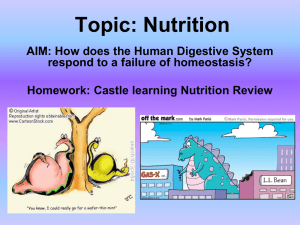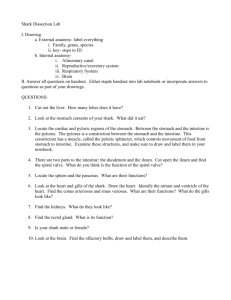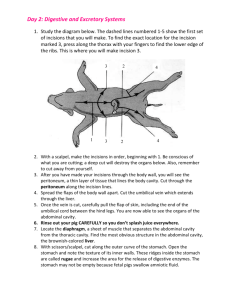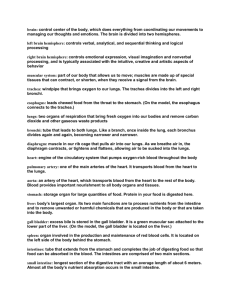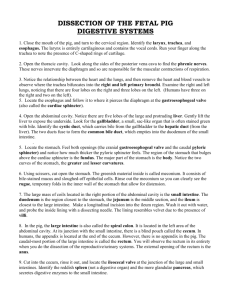fetal pig digestions system
advertisement
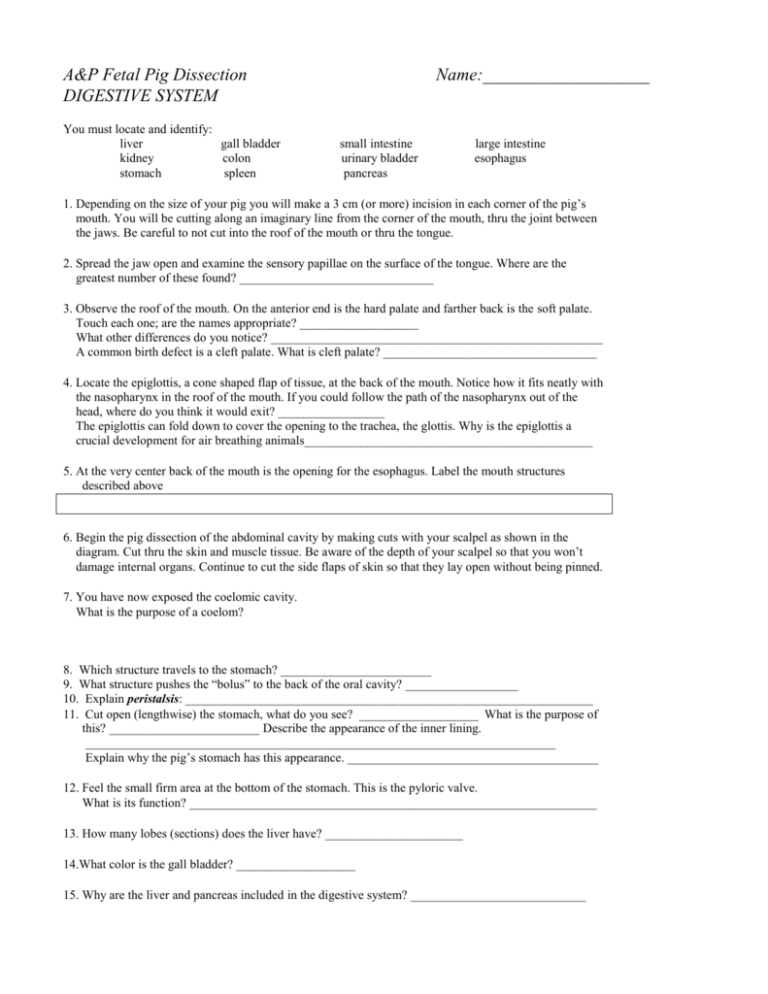
A&P Fetal Pig Dissection DIGESTIVE SYSTEM You must locate and identify: liver gall bladder kidney colon stomach spleen Name:___________________ small intestine urinary bladder pancreas large intestine esophagus 1. Depending on the size of your pig you will make a 3 cm (or more) incision in each corner of the pig’s mouth. You will be cutting along an imaginary line from the corner of the mouth, thru the joint between the jaws. Be careful to not cut into the roof of the mouth or thru the tongue. 2. Spread the jaw open and examine the sensory papillae on the surface of the tongue. Where are the greatest number of these found? _______________________________ 3. Observe the roof of the mouth. On the anterior end is the hard palate and farther back is the soft palate. Touch each one; are the names appropriate? ___________________ What other differences do you notice? _____________________________________________________ A common birth defect is a cleft palate. What is cleft palate? __________________________________ 4. Locate the epiglottis, a cone shaped flap of tissue, at the back of the mouth. Notice how it fits neatly with the nasopharynx in the roof of the mouth. If you could follow the path of the nasopharynx out of the head, where do you think it would exit? _________________ The epiglottis can fold down to cover the opening to the trachea, the glottis. Why is the epiglottis a crucial development for air breathing animals______________________________________________ 5. At the very center back of the mouth is the opening for the esophagus. Label the mouth structures described above 6. Begin the pig dissection of the abdominal cavity by making cuts with your scalpel as shown in the diagram. Cut thru the skin and muscle tissue. Be aware of the depth of your scalpel so that you won’t damage internal organs. Continue to cut the side flaps of skin so that they lay open without being pinned. 7. You have now exposed the coelomic cavity. What is the purpose of a coelom? 8. Which structure travels to the stomach? ________________________ 9. What structure pushes the “bolus” to the back of the oral cavity? __________________ 10. Explain peristalsis: _________________________________________________________________ 11. Cut open (lengthwise) the stomach, what do you see? ___________________ What is the purpose of this? ________________________ Describe the appearance of the inner lining. ___________________________________________________________________________ Explain why the pig’s stomach has this appearance. ________________________________________ 12. Feel the small firm area at the bottom of the stomach. This is the pyloric valve. What is its function? _________________________________________________________________ 13. How many lobes (sections) does the liver have? ______________________ 14.What color is the gall bladder? ___________________ 15. Why are the liver and pancreas included in the digestive system? ____________________________ 16. Notice the thin membrane that is between the internal organs. This is the mesentery. What is its function? __________________________________________________________________________ 17. Under the liver is the stomach. The anterior end is called the cardiac stomach and the posterior end is the pyloric stomach. Why would the anterior end be named the cardiac stomach? _________________ 18. Feel the point at which the stomach and the small intestines meet. This is called the pyloric sphincter. What is its function? ________________________________ 19. Continuing posteriorly is the small intestine. Follow it to where it enlarges to become the large intestines or colon. What is the main structural difference between the intestines? ______________________________ 20. Closely observe the membraneous netlike tissue that keeps the intestines coiled. Does it have blood vessels in it? __________________ Why? ________________________________________________ 21. The large intestine will enlarge and form the rectum. The point at which the rectum opens to the outside of the body is the anus. What structure in the frog is similar to the rectum in the pig? ___________________ 22. Relocate the stomach and trace it anteriorly to the esophagus. Why does the esophagus appear to be short? ____________________________________________________________________________ 23. Embedded in the right central lobe of the liver is the greenish gall bladder. What enzyme does the gall bladder store and release? ________________________ What does this enzyme help digest? _________ Can you find the bile duct that leads from the gall bladder to the intestines? ___________ 24. Directly underneath the stomach, you will find a granular looking organ, the pancreas. How does the pancreas aid in digestion? ___________________________________________________________ 25. Attached to the top of the stomach is a smooth reddish organ that looks like a tongue. This is the spleen. It does not belong to the digestive system. What is its function? ________________________ 26. The stomach is also a muscle. What type of muscle is it? ____________________ 27. Look at the cardiac and pyloric sphincters from the inside. Describe their appearance. ______________________________________________________________________________________ 28. Cut open a lengthwise section of the small intestines. Examine the inside. Describe its appearance. ____________________________________________________________ 29. These structures are called villi. How do they aid in the function of the small intestine? _____________________________________________________________________________________ 30. Uncoil the entire small intestine and determine its length _______cm. Also find the caecum .
